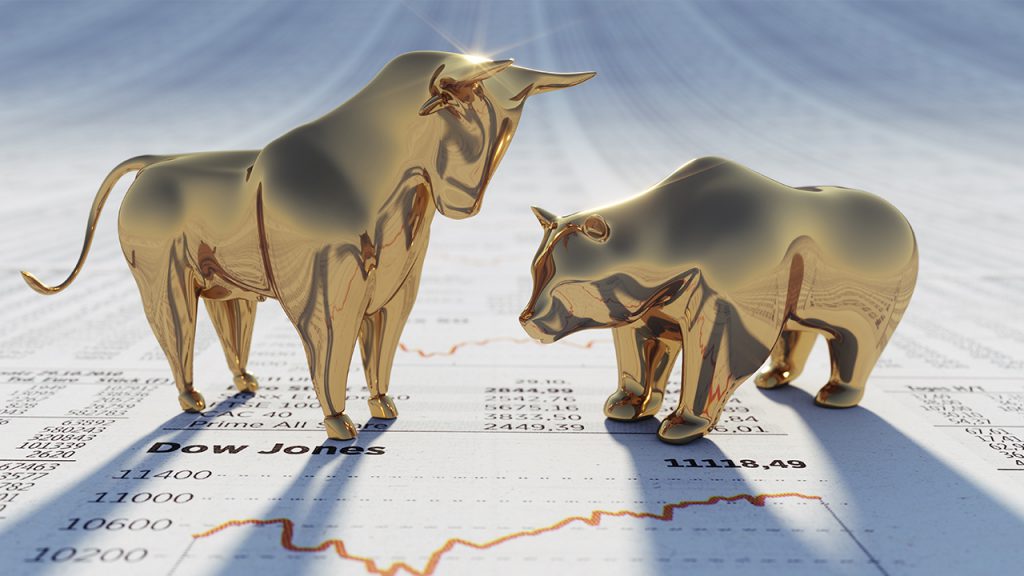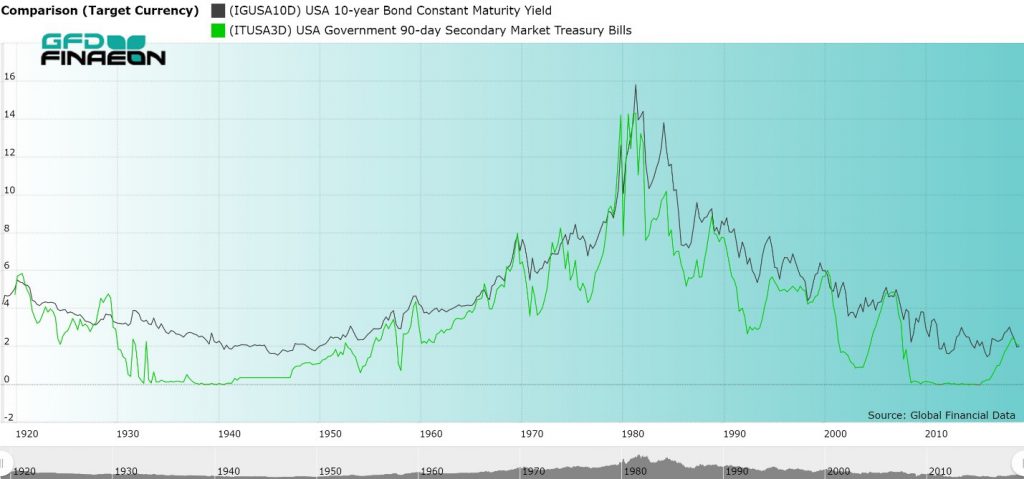 Bear markets are clearly defined: a decline of 20% or more in an equity market constitutes a bear market. By this definition, the United States had 18 bear markets in the 1900s. But what is a bull market? Global Financial Data (GFD) has supplemented the definition of a bear market with the requirement that the intervening gain should show a rise of at least 50% before the 20% decline sets in. Otherwise, successive declines without a bounce back could be treated as multiple bear markets when actually there was only one long, extended bear market.
But what about fixed income markets? They go through bull and bear markets just like equity markets, but there is no definition of what would define a bull or bear market in fixed income markets. So let’s see if we can come up with rules for defining bull and bear markets in fixed-income markets. There are several facts that need to be considered.
Bear markets are clearly defined: a decline of 20% or more in an equity market constitutes a bear market. By this definition, the United States had 18 bear markets in the 1900s. But what is a bull market? Global Financial Data (GFD) has supplemented the definition of a bear market with the requirement that the intervening gain should show a rise of at least 50% before the 20% decline sets in. Otherwise, successive declines without a bounce back could be treated as multiple bear markets when actually there was only one long, extended bear market.
But what about fixed income markets? They go through bull and bear markets just like equity markets, but there is no definition of what would define a bull or bear market in fixed income markets. So let’s see if we can come up with rules for defining bull and bear markets in fixed-income markets. There are several facts that need to be considered.
Bull and Bear Fixed Income Cycles
First, there is a greater correlation between individual fixed income instruments than between individual equities. If interest rate yields rise on a particular day and bond prices fall, almost all bond prices will fall. In bond markets, you lack the dispersal of advances and declines that occur in the equity markets. Over time, risk spreads between different bonds will rise and fall. During a recession when the risk of default increases on low quality bonds, the yield difference between AAA and BB bonds widens, but during a strong market, this difference shrinks. Maturity also influences relative interest rates. As is well known, the yield curve which measures the spread between short-term and long-term bonds, is usually positive. However, as the economy approaches a recession, short-term yields can exceed long-term yields and act as an indicator of a pending recession. Second, bull and bear markets are generally longer for fixed income instruments than for equities. The reason for this is that three things generally drive interest rates: risk of default, maturity and inflation. Equities, on the other hand, are typically driven by anticipated future earnings. When a recession is looming and investors anticipate that future earnings will decline, shares can decline in price quickly. When the recession is over and earnings return, the price of equities can rise dramatically. There were 18 bear markets in the United States in the 1900s, meaning that one occurred every five or six years. However, if you look at bond yields, the rises and falls in the yield on the 10-year bond stretches over longer time periods. Bond yields fell from the 1780s to 1830s, rose until the Civil War in the 1860s, declined to around 1900, rose until 1920, declined to 1950, rose to 1981 and have declined steadily since then. Bull and bear markets in equities may last around 6 years, but bull and bear markets in fixed income markets last 40 or 50 years. The current rise and fall began in 1945 and has lasted almost 75 years. Bond yields have been declining since 1981 and there is no evidence that they have hit their bottom. Bond yields are negative in some European countries and there is no guarantee that bond yields couldn’t also turn negative in the United States at some point in the future. Bond yields could theoretically remain low or continue their decline for another decade. Risk and reward work in opposite directions for short-term and long-term fixed-income investors. For short-term holders of Treasury Bills, there is virtually no default risk, but there is reinvestment risk. When interest rates are rising, this works to the advantage of investors who are likely to receive a higher return when they reinvest their money after the 3-month T-bills mature. When short-term yields are falling, investors will receive a lower return when they reinvest their money. On the other hand, rising bond yields mean lower bond prices, reducing the return to investors. Hence, a bull market for short-term holders of T-bills is a bear market for long-term holders of 10-year Treasury Bonds. Figure 1 compares the yield on the 10-year Government bond with the yield on 3-month Treasury Bills over the past 100 years. Short-term yields are usually less than long-term yields. The long-term pattern of rising and falling yields over a period of several decades is visible. In addition to this, it can be seen that short-term rates are more volatile than long-term rates, rising above long-term rates as a prelude to a recession and plunging below long-term rates once the economy recovers.
Figure 1. Yields on 10-year Bonds and 3-month T-bills, 1919 to 2019
Although there have been only two bull and bear markets in 10-year bonds over the past 100 years, there have been 17 bull and bear markets in 3-month Treasury Bills over the past 100 years. But how would you define a bull and bear market in Treasury bills? We say that in order for there to be a bull or bear markets, you need to have at least a 200-basis point move up or down in the yield. Although 10-year bond yields have been in a downward trend since 1981, there have been dramatic moves up and down in the yield over time. If you were to limit yourself to 200-basis point moves in the 10-year bond, you would find that there have been six bear markets in 10-year bond yields since 1981, not one. Unfortunately, this definition might have limited usefulness in the future. With bond yields falling below 2% in recent years, it would be difficult to sustain a 200-basis point move. Table 1 provides the broad moves in 3-month Treasury Bills over the past century. Generally, a bull-bear market cycle in yields occurred about every five years, which is mainly a reflection of recessions occurring about every five years. Since 2000, however, the time required for the market to move through one of its bull-bear market cycles has increased to around 10 years.| Date | Yield | Decline | Date | Yield | Increase |
| 12/31/1920 | 5.875 | 5.875 | |||
| 8/31/1924 | 1.9 | 3.975 | 5/31/1929 | 5.09 | 3.19 |
| 7/31/1931 | 0.41 | 4.68 | 1/31/1932 | 2.681 | 2.271 |
| 12/31/1932 | 0.085 | 2.596 | 3/31/1933 | 2.289 | 2.204 |
| 1/5/1940 | 0 | 2.29 | 5/8/1953 | 2.29 | 2.2899 |
| 6/7/1954 | 0.61 | 1.68 | 10/16/1957 | 3.67 | 3.06 |
| 5/27/1958 | 0.55 | 3.12 | 1/6/1960 | 4.68 | 4.13 |
| 7/1/1960 | 2.05 | 2.63 | 9/21/1966 | 5.59 | 3.54 |
| 6/23/1967 | 3.33 | 2.26 | 12/29/1969 | 8.08 | 4.75 |
| 2/11/1972 | 2.99 | 5.09 | 8/23/1974 | 9.74 | 6.75 |
| 12/20/1976 | 4.24 | 5.5 | 3/25/1980 | 16 | 11.76 |
| 6/13/1980 | 6.18 | 9.82 | 12/11/1980 | 17.14 | 10.96 |
| 8/20/1982 | 7.08 | 10.06 | 8/27/1984 | 10.67 | 3.59 |
| 10/8/1986 | 5.04 | 5.63 | 3/27/1989 | 9.1 | 4.06 |
| 10/1/1992 | 2.61 | 6.49 | 2/1/1995 | 5.9 | 3.29 |
| 10/16/1998 | 3.56 | 2.34 | 11/6/2000 | 6.24 | 2.68 |
| 6/19/2003 | 0.8 | 5.44 | 2/20/2007 | 5.05 | 4.25 |
| 9/22/2011 | 0 | 5.05 | 3/21/2019 | 2.49 | 2.49 |
Table 1. Bull and Bear Market Cycles in 3-month U.S. Treasury Bills
The historical record on yield cycles for 10-year Treasury Bonds is provided in Table 2. As can be seen, the time cycles are longer than the 3-month cycles and the definition of a cycle depends upon the definition of how much of a move is required to define a bull-bear market cycle. There hasn’t been a 200-basis move up since the 2007 Great Recession occurred. And again, the move up from 1945 to 1981 could be defined as one long, extended increase in interest rates and the move since 1981 as one long move down. Moreover, there is no guarantee that interest rates have bottomed out and a new bear market in the price of 10-year bonds has begun. The yield on 10-year bonds has turned negative in both Europe and Japan and there is no reason why the same couldn’t happen in the United States. Only time will tell whether 2% moves up and down lie in our future.| Date | Yield | Decline | Date | Yield | Increase |
| 03/31/1788 | 24.615 | ||||
| 01/31/1792 | 3.956 | 20.659 | 09/30/1798 | 7.059 | 3.103 |
| 07/31/1802 | 4.511 | 2.548 | 10/31/1814 | 5.882 | 1.371 |
| 09/30/1832 | 2.996 | 2.886 | 05/31/1861 | 7.059 | 4.063 |
| 3/31/1902 | 2.86 | 4.199 | 8/30/1920 | 5.67 | 2.81 |
| 11/30/1945 | 1.55 | 4.12 | 10/31/1957 | 3.97 | 2.42 |
| 4/30/1958 | 2.88 | 1.09 | 8/7/1975 | 8.48 | 5.6 |
| 12/30/1976 | 6.8 | 1.68 | 2/26/1980 | 13.65 | 6.85 |
| 6/16/1980 | 9.47 | 4.18 | 9/30/1981 | 15.84 | 6.37 |
| 5/4/1983 | 10.12 | 5.72 | 5/30/1984 | 13.99 | 3.87 |
| 8/29/1986 | 6.95 | 7.04 | 10/16/1987 | 10.23 | 3.28 |
| 10/15/1993 | 5.19 | 5.04 | 11/7/1994 | 8.05 | 2.86 |
| 12/10/1998 | 4.53 | 3.52 | 1/20/2000 | 6.79 | 2.26 |
| 6/13/2003 | 3.13 | 3.66 | 6/12/2007 | 5.26 | 2.13 |
| 12/18/2008 | 2.08 | 3.18 | 4/5/2010 | 4.01 | 1.93 |
| 7/25/2012 | 1.43 | 2.58 | 12/31/2013 | 3.04 | 1.61 |
| 7/5/2016 | 1.37 | 1.67 | 11/8/2018 | 3.24 | 1.87 |
Table 2. Bull and Bear Market Cycles in U.S. 10-year Treasury Bonds

